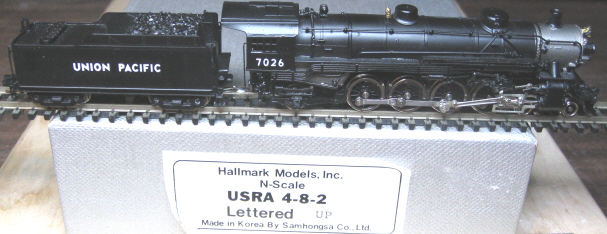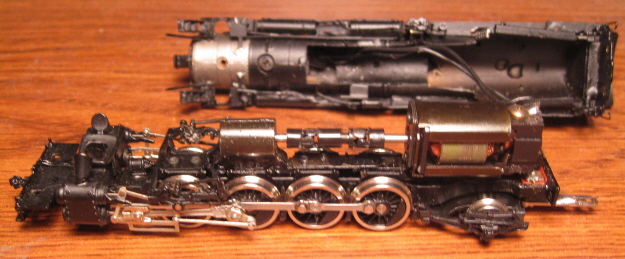

Introduced: 1992
Hallmark's USRA 4-8-2 is a very nice looking model. And although "as delivered" it has some issues, it does have the potential for being a fine runner (more on that in a moment).
The chassis is all metal, although it's also fairly minimalistic (with the shell providing most of the actual heft). The motor is an open-sided 5-poler. Right-rail pickup is provided by the four right-side drivers. Left-rail pickup is provided by the four left-side tender wheels. Current is transferred from the tender to the locomotive via a stiff wire on the drawbar. All the rest of the wheels are electrically neutral. Only the second pair of drivers (from the front) is geared (with the remaining drivers being turned solely by the cranks). The pilot coupler is a dummy (IE, non-operational) knuckle. There is no coupler on the tender (although a pocket and a screw are provided, so adding a Micro-Trains coupler looks to be a simple operation). The shell includes cab interior detailing. The pilot truck is sprung, providing downward pressure. All the wheels are low-profile, so no problems on Code-55 track. No problems on narrow radius (9.75") curves either. The drawbar has two holes - one for extreme close-coupling. No traction tires.

This locomotive actually has a directional headlight. Unfortunately, said light is also clearly visible through the smokestack (ick). Sadly, there isn't a pin/socket connector on the wiring running from the chassis to the headlight.
The actual locomotive mechanism is a good one. And running "wheels-up" on my workbench (with current applied directly to the motor contacts), it's just as smooth and as quiet as can be. However, there is a pick-up issue that needs to be addressed before this locomotive can be considered "operations worthy". The "stiff wire" current transfer scheme on the drawbar is simply not reliable. The wire is affixed to the drawbar fairly loosely, resulting in a lot free play. As a consequence, current conductivity is all over the map. Yes, if you get lucky and wind up with a solid connection when you hook the tender to the drawbar, this steamer will glide around the rails beautifully - smooth, quiet, great throttle response, no pickup problems, etc. Unfortunately, it's all the luck of the draw, and you're just as likely to get an iffy connection (and with the resultant stalls and stuttering one normally associates with bad pickup).
One simple solution to the problem is to apply a glob of solder to the wire where it connects to the drawbar - basically fixing it more firmly in place. I made this modification to mine and performance improved significantly. Unfortunately, even so modified the occasional stall seems inevitable (particularly through curves). A more ambitious fix would be to replace (or augment) the drawbar wire with an actual insulated wire (running from the tender to the motor). Unfortunately, running wires between tender and loco is never pretty. Still, it would definitely provide bulletproof electrical conductivity.
Another issue is pulling power (or the lack thereof). Without any traction tires to grip the rails, this loco can only pull about 10 cars on level track. Is that enough for a Mountain? I dunno, I guess that would be up to the individual modeler to decide. In any case, installing some sort of after-market traction tires (or Bullfrog Snot) would certainly help in that regard.
So overall, this is a gorgeous model that (with some minor modification) has the potential to be a very good runner. Unfortunately, "as delivered" it's not so great.
To remove the locomotive shell, unscrew the two small screws on the back (cab) end. Next, unscrew the screw holding the pilot truck to the chassis. The shell should lift up and off readily at that point (just be careful not to yoink the lighting wires). To completely separate the shell from the chassis, you have to unscrew the weight inside the boiler. Once freed up, the weight and the headlight bulb should slide out.
Grade: C (as delivered)